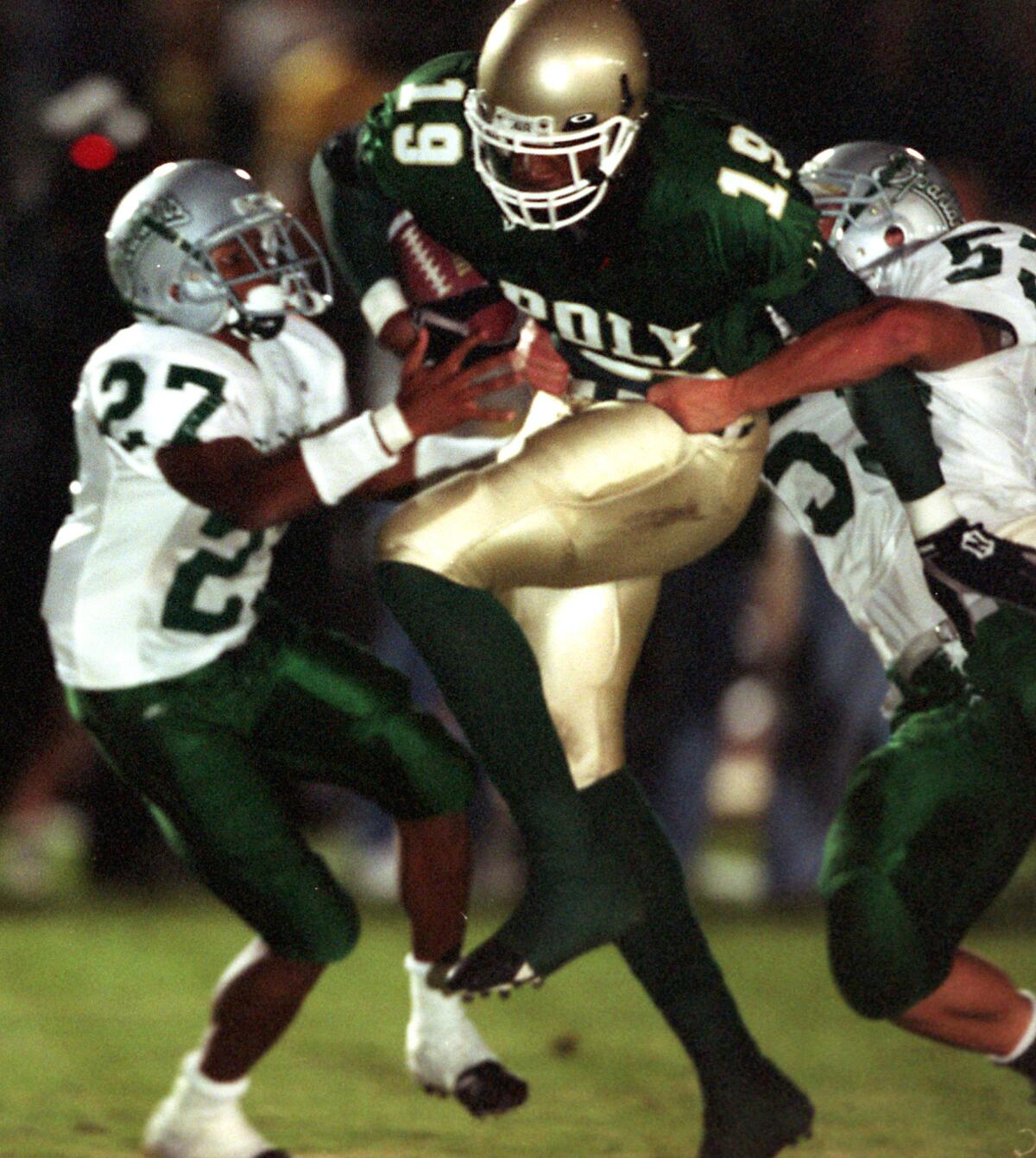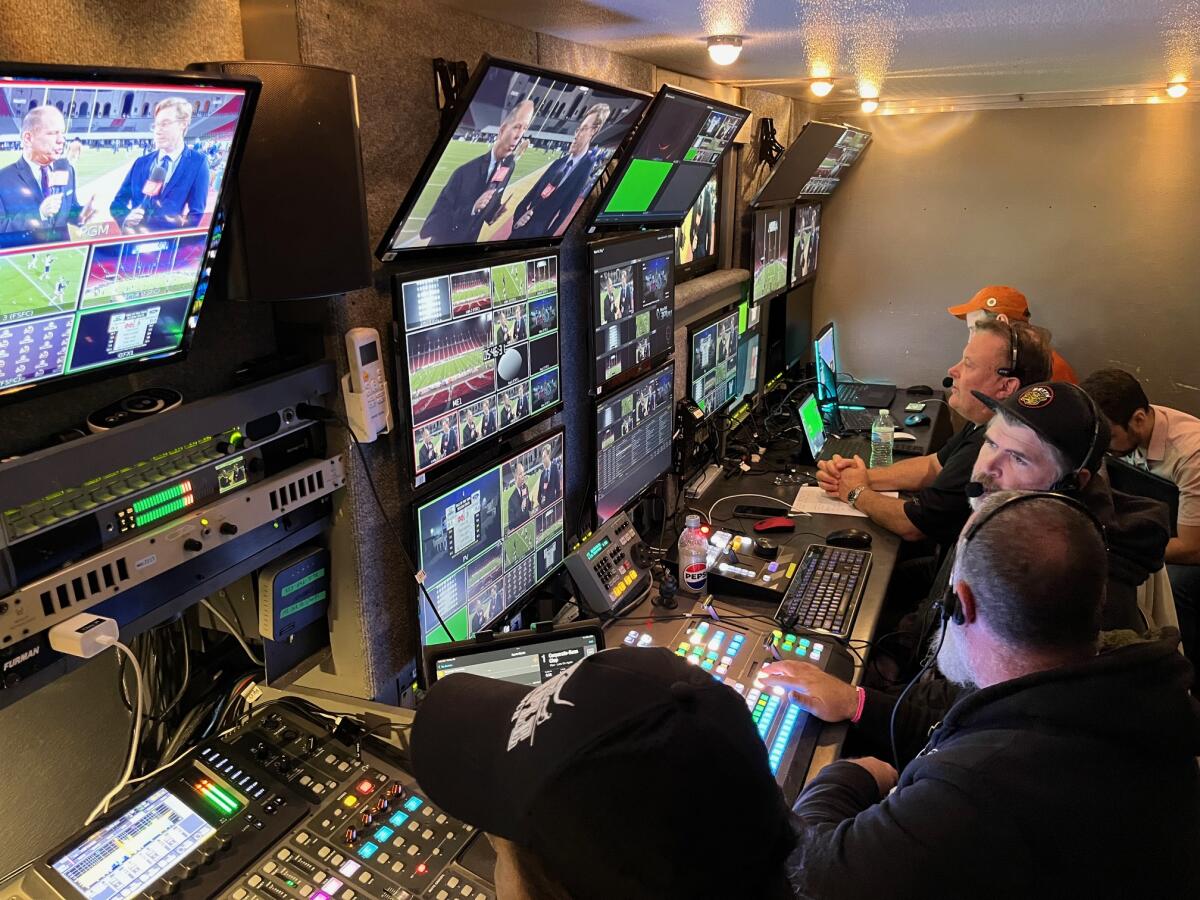Column: How Southern Section football became must-see TV

Kevin Rooney, the football coach and athletic director at Sherman Oaks Notre Dame, was on vacation in Lake Tahoe during the summer of 1997 when he received a call asking if heâd be willing to allow his teamâs game against Bishop Alemany to be part of the first high school sports telecast by Fox Sports West and Prime Ticket.
âI knew the players would be excited,â he said. âYou always worry about distractions but felt it was worth it.â
Notre Dame agreed to bring in portable lights for the broadcast. Alemany was led by future Tennessee quarterback Casey Clausen. Notre Dame was led by future USC and NFL running back Justin Fargas, plus future Florida State and NFL defensive tackle Travis Johnson. The ball boy was future NFL quarterback Jimmy Clausen.
âThey come to see you, but theyâre going to see me,â Johnson remembers telling Fargas. âIt was huge. I tell everyone we played in the first televised game on Fox Sports. I think I sacked Casey seven or nine times between three years.â
Itâs been 28 seasons of Southern Section TV games even though the channel names have changed so many times that it could be a sports category for $400 on âJeopardy!â In the latest change, Bally Sports is now FanDuel Sports Network, the naming rights bought by an online gambling company, which is a major reason the contract with the Southern Section that ends in May probably wonât be renewed and will switch to Spectrum.
Keeping the games on TV despite budget cuts has been David Otta Productions, which took over as a third party to produce the games in 2023. The Division 1 final from Veterans Stadium on Friday will feature announcers Cooper Perkins and Tony Moskal. The history of these games is filled with not only memorable moments but also rookie starts for on-air media personalities and many more behind-the-scenes personnel, from cameramen to Emmy-winning producers and directors who went on to be part of the industry. Announcers, commentators and sideline reporters have included Jim Watson, John Jackson, Lindsey Soto, Chris McGee, Chris Rix and Petros Papadakis, who won a 2020 Emmy with former Mater Dei coach Bruce Rollinson for their introduction of a 2019 broadcast in which Papadakis played a sports-radio talk show host receiving a call from âBruce in Santa Ana.â Rollinson asks, âAre you ready for high school football?â
One person who was around for the start was John Hefner, now the executive producer of FanDuel Sports Network West and SoCal. He was a 30-year-old Loyola High graduate and production assistant. The regional sports network was looking to build subscribers by showing high school football. The late Garry Paskwietz and Andy Bark from Student Sports helped pick games. Everything was done as if it were a broadcast of a pro game, with multiple cameras, a microwave truck filled with the best technology and first-class, behind-the-scene workers.
Hefner still remembers Watsonâs call from that first game. âJustin Fargas is gone âŚâ

The biggest game of all came in 2001 when Long Beach Poly faced Concord De La Salle in what was dubbed the game of the century. It was No. 1 vs. No. 2 before more than 17,000 at Veterans Stadium. It helped change the landscape of high school sports, prompting ESPN and others to jump into televising them.
âWe got the game cleared to air on all the Fox regions that night, so it was a national audience and a real showcase for football in California,â Hefner said. âWe had to explain to our bosses how big the game was going to be. They didnât buy it at first. âYeah, yeah, yeah.â But when they saw the rating it drew that night, they were blown away.â
Hefner and those on camera and off werenât just doing the games because it was a job. They truly loved the experience of bringing the best of Southern California high school football to viewers.
âIâve always had a passion for high school football and maybe an inflated vision for how big a deal it is,â said Papadakis, who has his own local sports talk radio show and continues to do commentary for college broadcasts. âI love the mascots, the regionalism, the towns. Iâd come back and do state championship games for years. The coolest thing was Iâd see the same players in college and theyâd go on to play pro ball and theyâd remember me for hugging their mom.â

One of the greatest individual performances was turned in by Matt Grootegoed of Mater Dei against Long Beach Poly in 1998. He rushed for 244 yards in 33 carries and scored two touchdowns in Mater Deiâs 33-26 victory. Watson and Jackson were the commentators.
The games of the week brought exposure to previously unknown players. Defensive tackle Mike Patterson picked up multiple sacks for Los Alamitos in a televised game, then was offered by USC the following Monday. Dave Anderson of Thousand Oaks had a huge game receiving in an upset of Westlake, then was offered by Colorado State.
Notre Dame defeated Alemany 43-15 in that first game. Fargas rushed for 217 yards and three touchdowns. Rooney said he decided not to put anything on his face for his TV debut.
âThey thought I was radiant, so I didnât have to put on makeup,â he said. âI kept expecting all of a sudden Iâd be a star. Never happened.â
Assistant coach Jeff Kraemer concluded, âHe wasnât discovered because he didnât put on enough makeup.â
So began a tradition that quickly was embraced and valued by the high school sports community and those doing the announcing in Southern California.
âWhen you humble yourself and you go to a high school game and deal with peopleâs kids and try your best to tell their story, those people never forget you, whether they go on to play in the NFL or never play again,â Papadakis said.
More to Read
Get our high school sports newsletter
Prep Rally is devoted to the SoCal high school sports experience, bringing you scores, stories and a behind-the-scenes look at what makes prep sports so popular.
You may occasionally receive promotional content from the Los Angeles Times.





